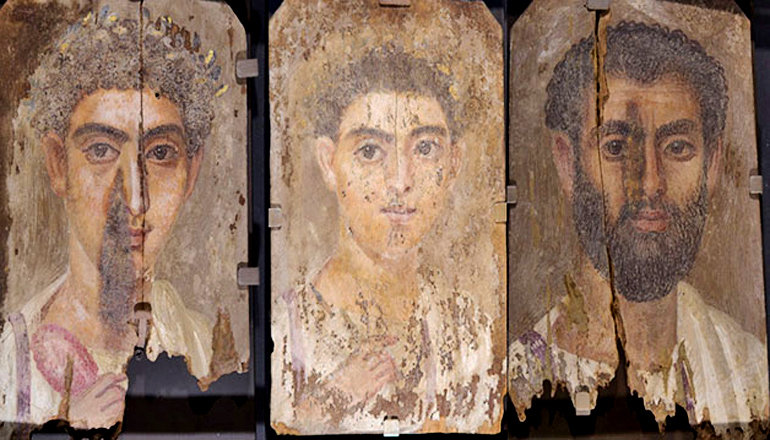EGYPTIAN BLUE HIDES IN THESE MUMMY PORTRAITS

Dusting off 15 Roman-era Egyptian mummy portraits—mostly untouched for 100 years—has revealed a 2,000-year-old surprise.
Researchers discovered that the ancient artists used the pigment Egyptian blue as material for underdrawings and for modulating color—a finding never documented before.
Because blue has to be manufactured, it typically is reserved for very prominent uses, not hidden under other colors.
“This defies our expectations for how Egyptian blue would be used,” says Marc Walton, research associate professor of materials science and engineering at Northwestern University.
“The discovery changes our understanding of how this particular pigment was used by artists in the second century AD. I suspect we will start to find unusual uses of this colorant in a lot of different works of art, such as wall paintings and sculpture.”
HIDDEN BLUE
The best Roman-era painters tried to emulate Greek painters, who were considered the masters of the art form. Before the Greek period, Egyptian blue was used everywhere throughout the Mediterranean—in frescoes, on temples, to depict the night sky, as decoration. But when the Greeks came along, their palette relied almost exclusively on yellow, white, black, and red.
“When you look at the Tebtunis portraits we studied, that’s all you see, those four colors,” Walton says. “But when we started doing our analysis, all of a sudden we started to see strange occurrences of this blue pigment, which luminesces. We concluded that although the painters were trying hard not to show they were using this color, they were definitely using blue.”
[QUICK QUIZ: OUR MEMORIES OF COLOR ARE SURPRISINGLY VAGUE]
“Our findings confirm the distinction between the visual and physical natures of artifacts—expect the unexpected when you begin to analyze an artwork,” says Jane L. Williams, a conservator at the Phoebe A. Hearst Museum of Anthropology and a coauthor, along with Walton, of the study. “We see how these artists manipulated a small palette of pigments, including this unusual use of Egyptian blue, to create a much broader spectrum of hues.”
LIFELIKE MUMMY PORTRAITS
The researchers studied 11 mummy portraits and four panel painting fragments. The 15 paintings were excavated between December 1899 and April 1900 at the site of Tebtunis (now Umm el-Breigat) in the Fayum region of Egypt. They now are housed in the collections of the Hearst Museum at the University of California, Berkeley.
The fragile mummy portraits are extremely lifelike paintings of specific deceased individuals. Each portrait would be incorporated into the mummy wrappings and placed directly over the person’s face, Williams explains.
[CT SCANS ‘UNWRAP’ SECRETS OF 3 MUMMIES]
While working on the conservation treatment of these paintings, Williams had many unanswered questions about their materials and techniques, but without a conservation science division at the Hearst Museum, she had limited means to investigate. Working with the Northwestern University-Art Institute of Chicago Center for Scientific Studies in the Arts (NU-ACCESS) made a comprehensive technical survey of the paintings possible, Williams says.
Walton and his team from Northwestern brought expertise in scientific analysis of cultural heritage materials and some of the latest technology for the non-destructive analysis of artworks to the Hearst Museum.
SHINE AND GLISTEN
The researchers uncovered the unexpected uses of Egyptian blue—the first human-made pigment, inspired by lapis lazuli, the true blue—using a routine battery of analytical techniques, such as X-ray fluorescence and X-ray diffraction. Six of the 15 paintings have the unusual use of blue, the researchers find.
[NANOTECH ‘PAINTS’ TEENY TINY MONA LISA]
The skilled painters employed blue for underdrawings, to modulate clothes, the shading on clothing, and in other not necessarily intuitive uses of Egyptian blue, a pigment used for millennia before these paintings were made.
“We are speculating that the blue has a shiny quality to it, that it glistens a little when the light hits the pigment in certain ways,” Walton says. “The artists could be exploiting these other properties of the blue color that might not necessarily be intuitive to us at first glance.”
In addition to Walton and Williams, other authors of the paper in Applied Physics A are from Northwestern and the Getty Conservation Institute.
The Andrew W. Mellon Foundation supports NU-ACCESS, which is based at Northwestern’s McCormick School of Engineering and Applied Science. Walton is a senior scientists with NU-ACCESS.
Политика конфиденциальности | Правила пользования сайтом







